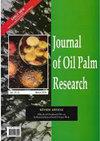从废弃烹饪棕榈油中提取用于去除 Cu2+ 的反相钒化多硫化物吸附剂
IF 1.3
4区 农林科学
Q2 Agricultural and Biological Sciences
引用次数: 0
摘要
重金属被认为对人体有毒。重金属通常由石化厂和杀虫剂生产过程中产生,人们利用各种技术来处理受重金属(如铜 (Cu 2+ ))污染的废水。本文主要介绍利用多硫化物吸附剂的吸附作用,通过反硫化法处理废水。马来西亚每天产生大量废弃烹饪棕榈油 (WCO),这促使研究人员生产出一种具有高去除效率的低成本吸附剂。多硫化物吸附剂由硫磺粉和废食用油按 9:1 的比例制备而成。采用间歇吸附法研究了接触时间、初始 Cu 2+ 浓度和吸附剂用量的影响。用 5 克吸附剂处理 5 毫克/升的 Cu 2+ 水溶液时,去除率最高,达到 77.81%。Freundlich 和 Langmuir 等温线用于模拟 Cu 2+ 在水介质中的吸附,其中以 Langmuir 等温线的模拟效果最佳。总之,这些结果证实了多硫化物是一种低成本、有潜力去除废水中 Cu 2+ 的吸附剂。本文章由计算机程序翻译,如有差异,请以英文原文为准。
INVERSE VULCANISED POLYSULPHIDE ADSORBENT FROM WASTE COOKING PALM OIL FOR Cu2+ REMOVAL
Heavy metals are considered to be toxic to humans. Commonly produced by petrochemical plants and pesticide productions, various techniques have been utilised to treat wastewater contaminated with heavy metal such as copper (Cu 2+ ). This article focuses on using adsorption by utilising polysulphide adsorbent to treat wastewater via inverse vulcanisation. The huge amount of waste cooking palm oil (WCO) that is generated daily in Malaysia has motivated the study to produce a low-cost adsorbent with high removal efficiency. The polysulphide adsorbent was prepared with sulphur powder and waste cooking oil with a ratio of 9:1. The effect of contact time, initial Cu 2+ concentration, and adsorbent dosage were studied using a batch adsorption process. The highest removal efficiency was 77.81% obtained while using 5 g of adsorbent dosage to treat 5 mg/L of Cu 2+ aqueous solution. The Freundlich and Langmuir isotherm was used for modelling Cu 2+ adsorption in an aqueous medium which was modelled best by the Langmuir isotherm. Overall, these results confirmed polysulphide as a low-cost and potential adsorbent to remove Cu 2+ from wastewater.
求助全文
通过发布文献求助,成功后即可免费获取论文全文。
去求助
来源期刊

Journal of Oil Palm Research
农林科学-食品科技
CiteScore
2.60
自引率
30.80%
发文量
69
审稿时长
>12 weeks
期刊介绍:
JOURNAL OF OIL PALM RESEARCH, an international refereed journal, carries full-length original research papers and scientific review papers on various aspects of oil palm and palm oil and other palms. It also publishes short communications, letters to editor and reviews of relevant books. JOURNAL OF OIL PALM RESEARCH is published four times per year, i.e. March, June, September and December.
 求助内容:
求助内容: 应助结果提醒方式:
应助结果提醒方式:


